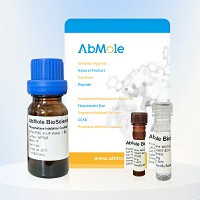
Programmed cell death 1 ligand 1 (PD-L1) is also known as cluster of differentiation (CD274) or B7 homolog 1 (B7-H1), is a member of the growing B7 family of immune molecules and is involved in the regulation of cellular and humoral immune responses. PD-L1 is highly expressed in the heart, skeletal muscle, placenta and lung and weakly expressed in the thymus, spleen, kidney and liver. PD-L1 is expressed on activated T-cells, B-cells, dendritic cells, keratinocytes and monocytes. PD-L1 is up-regulated on T- and B-cells, dendritic cells, keratinocytes and monocytes after LPS and IFNG activation and up-regulated in B-cells activated by surface Ig cross-linking. PD-L1 involve in the costimulatory signal, essential for T-cell proliferation and production of IL10 and IFNG, in an IL2-dependent and a PDCD1-independent manner.
Accession: # Q9NZQ7-1
Apparent Molecular Weight: 31~35 kDa, on SDS-PAGE under reducing conditions.
Immobilized PD-L1, His, Human at 2.0 μg/ml (100 μl/well) can bind PD-1, Human.
Lyophilized from a 0.2 μm filtered solution in PBS, 5% trehalose and mannitol.
| Solubility (25°C) | Reconstitute the lyophilized powder in ddH2O or PBS to 100 μg/ml |
| Storage | Stable for up to 6 months at lower than -70°C |
| Species | Mouse | Rat | Rabbit | Guinea pig | Hamster | Dog |
| Weight (kg) | 0.02 | 0.15 | 1.8 | 0.4 | 0.08 | 10 |
| Body Surface Area (m2) | 0.007 | 0.025 | 0.15 | 0.05 | 0.02 | 0.5 |
| Km factor | 3 | 6 | 12 | 8 | 5 | 20 |
| Animal A (mg/kg) = Animal B (mg/kg) multiplied by | Animal B Km |
| Animal A Km |
For example, to modify the dose of Compound A used for a mouse (20 mg/kg) to a dose based on the BSA for a rat, multiply 20 mg/kg by the Km factor for a mouse and then divide by the Km factor for a rat. This calculation results in a rat equivalent dose for Compound A of 10 mg/kg.
[2] Qingqing Xiao, et al. Acta Pharm Sin B. Biological drug and drug delivery-mediated immunotherapy
| Related Recombinant Proteins Products |
|---|
| Recombinant Mouse Lumican (Mammalian, C-6His)
Lumican binds to laminin. It has positive regulation of transcription from RNA polymerase II promoter and transforming growth factor beta1 production. |
| Recombinant Human Serpin A12 (E.coli, N-GST)
Vaspin (Visceral Adipose-Specific SERPIN) is a newly described adipokine. Vaspin is also a unique insulin sensitizing adipocytokine in obesity. |
| Recombinant Human B2M Protein (Mammalian, C-6His)
β-2-Microglobulin (B2M) is a secreted protein with 1 Ig-like C1-type (immunoglobulin-like) domain which belongs to the beta-2-microglobulin family. B2M may adopt the fibrillar configuration of amyloid in certain pathologic states. |
| Recombinant Mouse E-Selectin/CD62E Protein (HEK293)
E-selectin, also known as endothelial leukocyte adhesion molecule-1 (ELAM-1) and CD62E, is an inducible adhesion molecule that is expressed on the surfaces of stimulated vascular endothelial cells and is sometimes involved in cancer cell metastasis. |
| Recombinant Human DPP4/CD26 (Mammalian, C-6His)
DPP4/CD26 is a signal-anchor for type II membrane protein that belongs to the peptidase S9B family. DPP4/CD26 acts as a positive regulator of T-cell coactivation, by binding at least ADA, CAV1, IGF2R, and PTPRC. It’s binding to CAV1 and CARD11 induces T-cell proliferation and NF-kappa-B activation in a T-cell receptor/CD3-dependent manner. |


Products are for research use only. Not for human use. We do not sell to patients.
© Copyright 2010-2023 AbMole BioScience. All Rights Reserved.
